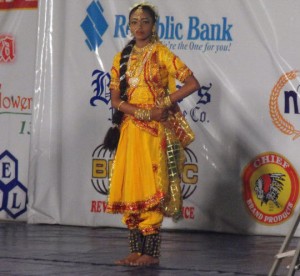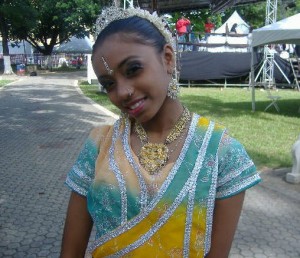 When she was only ten years old, Shalini toured the USA performing in several states on the request of promoters who were seeking out child stars of the Caribbean. She did a folk dance sung by India’s Ila Arun for Mastana and other stages. She also did a film dance adapted from the movie Gopala Krishna for the religious stage.
When she was only ten years old, Shalini toured the USA performing in several states on the request of promoters who were seeking out child stars of the Caribbean. She did a folk dance sung by India’s Ila Arun for Mastana and other stages. She also did a film dance adapted from the movie Gopala Krishna for the religious stage.
“The stage is my second home. I feel very comfortable there. It is no longer nerve wracking or frightening for me to be in front thousands of people,” she stated, adding that she is in love with the stage and looks forward to performing for people.
Apart from the fact that Shalini is an excellent dancer she considers herself a people’s person with an easy disposition. She smiles easily setting her audience at ease, once she enters the stage. She is quick to answer questions and even starts up a conversation whenever it is necessary. “It just takes a few words to make somebody happy. Paying a compliment to someone is the easiest thing to do. And the rewards are huge as you make friends and you have people on your side,” she said smilingly. It is always good to spread a little love where it is most needed, she says.
Shalini’s major aspiration is to travel to India where she can learn some of the basic art forms in dance. Apart from practising and performing Shalini has done research in the dances of India and she is now most interested in practising the “ghoomar dance”.
“The performers carry earthen pots and dance with slick movements of the hands and feet. Although this is essentially a group dance, sometimes performers show-off their skills by dancing independently. This is basically a community dance for women and performed on auspicious occasions. The famous ‘ghoomar’, Rajasthan’s popular dance gets its name from ‘ghoomna’, the graceful gyrating, which displays the spectacular colours of the flowing ‘ghaghra’, the long skirt of the Rajasthani women,” she explained.
She also admires the exponents of the art of Manipuri dance which is the classical dance from the Manipur region in the North East India. “It is slow and gracious movements which differentiate Manipuri from other dance styles. The delicate arm movements and gentle foot work characterise this dance. The repertoire is dominated by the themes from the Vishnu Puranas, Bhagvata Puranas, and Geeta Govinda. Manipuri dance is very much religious and associated to Vaishnavs in Hinduism,” she said.
She is also taken by the Dandiya dance which she says is very simple dance and is performed by a group of dancers who move in circles to measure steps, marking time by sticks called dandia. “Dandiya is the featured dances of Navratri evenings in Gujarat. The sticks of the dance represent the sword of Durga. Women normally perform it in a graceful and rhythmic manner in a circle as they rotate around the ‘mandvi’. The women wear traditional dresses such as colourful embroidered choli (blouse), ghagra (skirt) and bandhani dupattas (orni) dazzling with mirror work and heavy jewelry,” she said.
In the Bollywood Film Industry Shalini looks up to the stars of yesteryear like Hema Malini and Rekha. She also loves to look at Aishwarya Rai and Madhuri Dixit. “Imagine we are related to these people from India. You never know who is your distant cousins among these stars because we resemble them any way,” she said. She believes that real beauty is being able to express one’s art with everything one has. That is, she says, body and soul. 
She is now attached to the SWAHA College Dance Group as well as the Shakti Devi Dance Company.